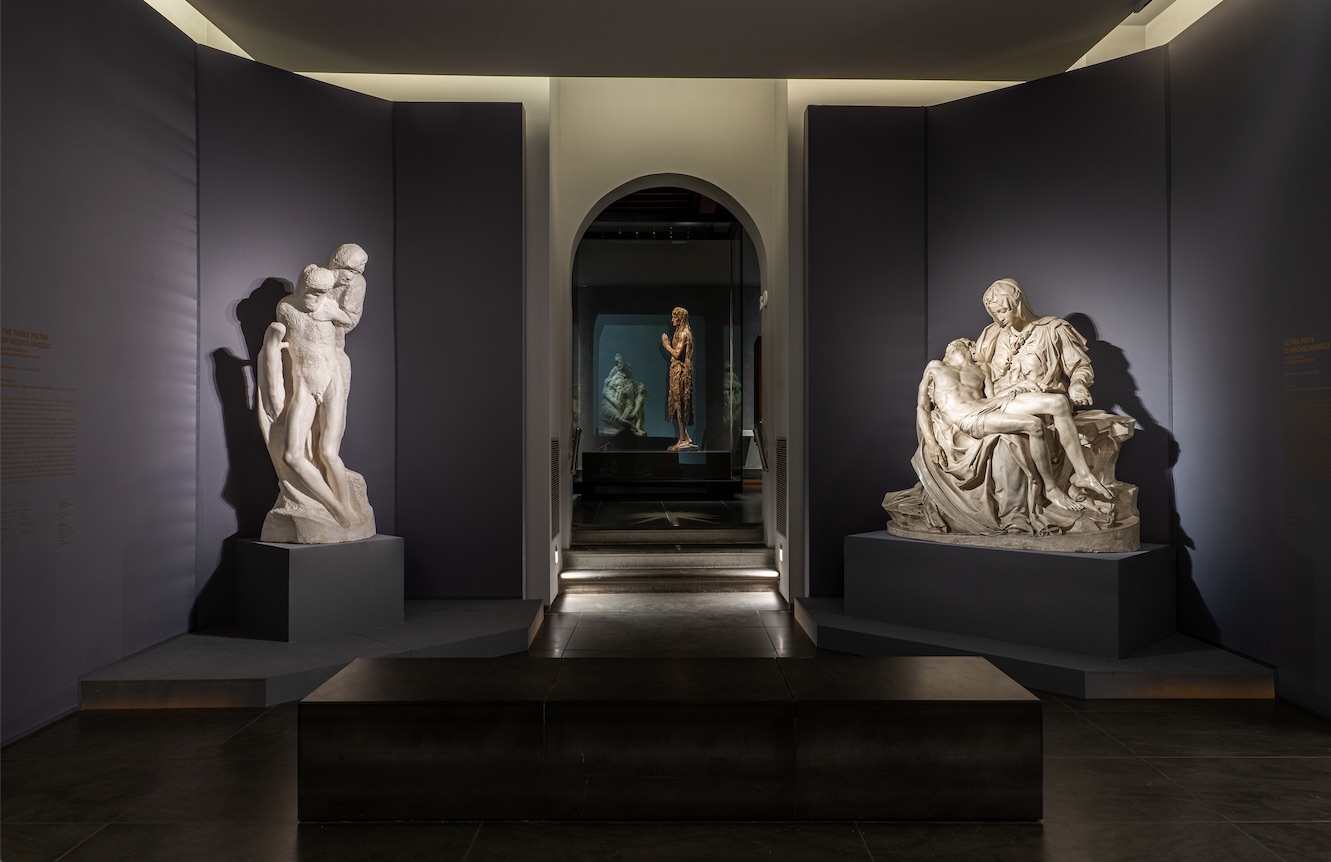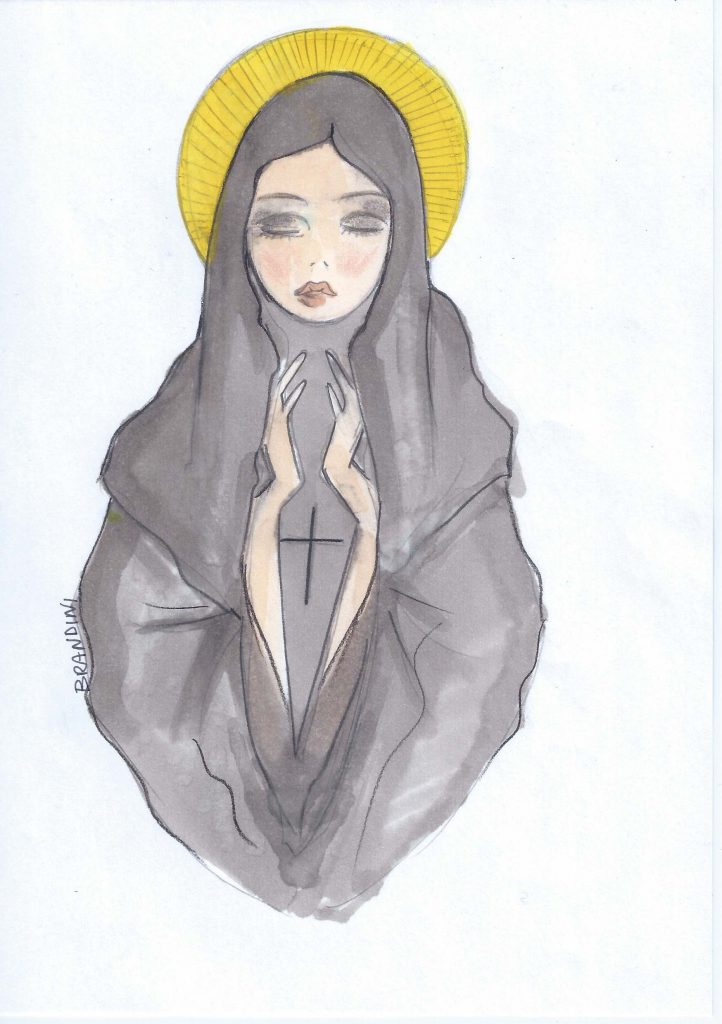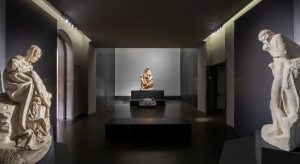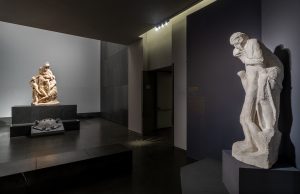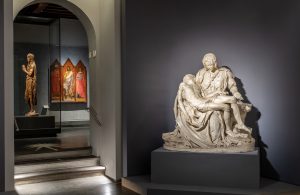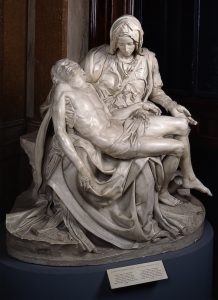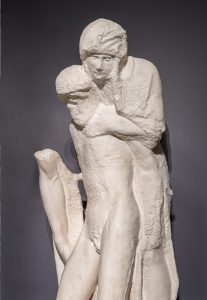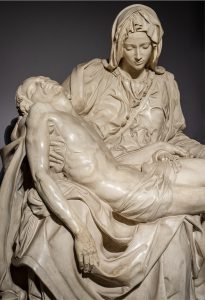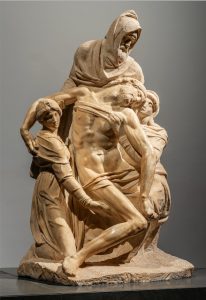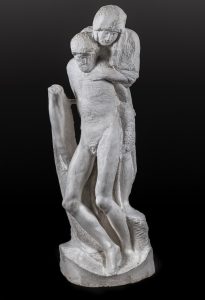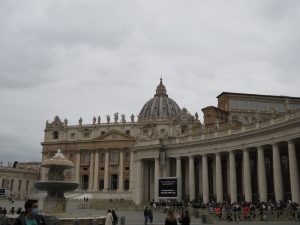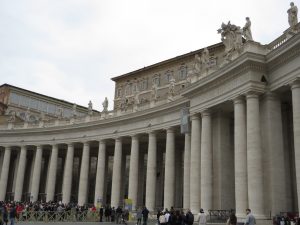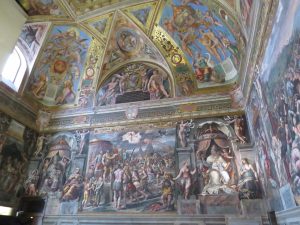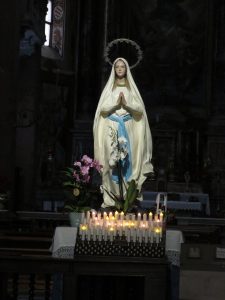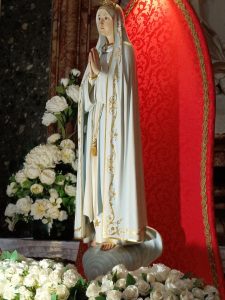Picture of the exhibition: ”The Three Pietà by Michelangelo. You don’t think how much blood it costs “. Photo Ela Bialkowska OKNOstudio
“Maria” by Beatrice Brandini
From 24 February to 1 August 2022, on the occasion of the Mediterranean meeting frontier of peace 2022, which will bring together the Bishops and Mayors of the Mediterranean in Florence, in which Pope Francis will also speak, the exhibition will open to the public in the Museo dell’Opera del Duomo: THE THREE PIETAS OF MICHELANGELO. You don’t think how much blood it costs.
Images of the exhibition: “The Three Pietàs of Michelangelo, You don’t think how much blood costs”. Photo Ela Bialkowska OKNOstudio
It is the first time that an exhibition compares these three masterpieces, namely the original of the Bandini Pietà, which has recently been restored, and the casts of the Vatican Pietà and the Rondanini Pietà, from the Vatican Museums.
Picture of the exhibition: “The Three Pietàs of Michelangelo, You don’t think how much blood costs”. Photo Ela Bialkowska OKNOstudio
The exhibition, curated by the museum directors Barbara Jatta, Sergio Risaliti, Claudio Salsi, Timothy Verdon, involves the Vatican Museums, the Museo dell’Opera del Duomo, the Museo Novecento in Florence, the Castello Sforzesco in Milan, and the institutions of Opera di Santa Maria del Fiore, Municipality of Florence, Municipality of Milan and Fabbrica di San Pietro.
Cast of the Vatican Pietà by Michelangelo Buonarroti. Photo Ela Bialkowska OKNOstudio
It is a unique opportunity to see Michelangelo’s three Pietàs close together, and to understand the evolution of one of the greatest artists of all time. A journey lasting more than fifty years, which leads us to the ambition of the young man who “with impunity” carved his name in the breast of the Madonna in the Vatican version, from the personal identification of the elderly artist, who in that of the Museo dell’Opera del Duomo di Firenze portrays himself in the likeness of Nicodemus.
Close to his death, Michelangelo meditated deeply on the Passion of Christ, in one of his drawings donated to the Marquise of Pescara Vittoria Colonna, he split Dante’s sentence: “You don’t think how much blood costs” (Paradiso XXIX). The sublime result of this spiritual meditation was the execution of the Rondanini Pietà.
Detail of the cast of the Pietà Rondanini by Michelangelo Buonarroti. Photo Ela Bialkowska OKNOstudio
“The comparison of these three works allows us to measure Buonarroti’s stylistic growth in the fifty years that the youthful Pietà separate for from the other two, and the much more concentrated and even dramatic evolution between the Florentine and Milanese Pietà”. Timothy Verdon director of the Opera del Duomo Museum.
For Sergio Risaliti, Director of the Museo Novecento Firenze: “This exhibition is held in a moment of exceptional historical value for the city of Florence which at the end of February will be the scene of a meeting of peace and dialogue between religious, political and spiritual authorities from all the Mediterranean countries…. And how not to recognize in the three Pietà the pain of others, of the last ones who are looking for a safe haven, justice and brotherhood. “
“It is truly extraordinary the opportunity to be able to admire, next to the Bandini Pietà, the other two sculptures that Michelangelo Buonarroti created during his long life thinking about the theme of the Pietà …” Claudio Salsi Director of the Superintendence Castle Area, Archaeological Museums and Museums Historians, Milan.
Cast of the Vatican Pietà by Michelangelo Buonarroti. Courtesy of the Vatican Museums. Photo Ela Bialkowska OKNOstudio
The three Pietà sculpted by Michelangelo:
Michelangelo’s first Pietà was made between 1498 – 1499, the Vatican Pietà, this work caused a sensation by impressing everyone, both for the beauty of the naked Christ and for a Madonna that is too “young” . Michelangelo wants to tell us that faith keeps pure and beautiful and that Christ, just taken down from the cross, is the most beautiful of living beings, he seems to be sleeping. Madonna, wrapped in a riot of drapery, lovingly supports her son.
The Pietà dell’Opera del Duomo also known as Pietà Bandini by Michelangelo Buonarroti.
The second Pietà, the Bandini Pietà, sculpted when Michelangelo was already old (1547), was never completely completed, it also suffered vicissitudes, such as the hammering inflicted by the artist himself on his work. Michelangelo was increasingly focused on human destiny, on the death and resurrection of Christ, these torments are reflected in this masterpiece.
Cast of Michelangelo Buonarroti’s Pietà Rondanini (original at Castello Sforzesco, Milan). Photo Ela Bialkowska OKNOstudio
The last Pietà (1552 – 1553) called Rondanini, was sculpted by the great artist to the end. This sculpture was in fact found in Michelangelo’s studio after his death. It is a prayer, the artistic demonstration of the fact that the man of faith has seen beyond real appearances, the hand is unable to return what the inner eye has been able to contemplate.
St. Peter’s Square, Rome
I have just returned from a weekend in Rome, where I wanted to take my son to see St. Peter’s and the Vatican Museums. For days we have felt within ourselves the amazement, the suggestion, the beauty and the love that we have stolen in every corner of those magical places. It is a stage that I recommend to anyone of any (or not) religion.
View inside the Vatican Museums, Rome
On the threshold of a probable and feared new armed conflict, I wonder above all why and if these people have ever visited Rome …
Madonna in a church in Rome
Sant’Agnese in Agone, Navona square, Rome
Good life to everyone
Beatrice


